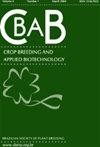Genotype-environment interaction in maize hybrids: an application of the AMMI model
IF 1.1
4区 农林科学
Q3 AGRONOMY
引用次数: 7
Abstract
The genotype-environment interaction is generally recognized when the same genotype is assessed in different environments, having a decisive influence in cultivar recommendation. Maize hybrids that are only adapted to particular environments can become a limiting factor to seed production in large scale. One of the main objectives of breeders is the obtainment of a hybrid with high mean yield and good adaptation to different environments. The present study assessed the grain yield stability in thirty-six maize genotypes in ten environments located in Central Brazil in the 1999/2000 growing season. The analysis of variance (ANOVA) detected significance (P<0.01) for the genotype-environment interaction (GE). The AMMI model (additive main effects and multiplicative interaction) was used to assess the additive and multiplicative effects of the interaction. The results indicated homogeneity of environments assessed and high correlation of the hybrid genetic constitution with the yield stability of the three types studied -single, triple and double crosses maize hybrids. The first multiplicative component of the interaction explained more than half (50.6%) of the original sum of squares (SS GE ). Most of the environments were neutral in their contribution to the interaction. The Uberlândia environment contributed positively, while the environment in Patos de Minas contributed negatively to the GE interaction. Most of the genotypes also presented a low contribution to interaction. Some single crosses hybrids presented greater mean yield (10182.0 kg.ha -1 ) while the double crosses hybrids presented greater stability to the玉米杂交种基因型-环境互作:AMMI模型的应用
基因型-环境互作是在不同环境下对同一基因型进行评价时普遍认识到的,对品种推荐具有决定性影响。只适应特定环境的玉米杂交种可能成为大规模种子生产的限制因素。育种者的主要目标之一是获得高平均产量和对不同环境有良好适应性的杂交种。本研究评估了1999/2000年巴西中部10种环境下36种玉米基因型的粮食产量稳定性。方差分析(ANOVA)发现基因型-环境相互作用(GE)具有显著性(P<0.01)。采用AMMI模型(可加性主效应和乘性相互作用)评价相互作用的可加性和乘性效应。结果表明,所评价的环境均一性和杂交遗传构成与单交、三交和双交玉米杂交种的产量稳定性高度相关。相互作用的第一个乘法分量解释了原始平方和(SS GE)的一半以上(50.6%)。大多数环境对互动的贡献是中性的。uberlindia的环境对GE的相互作用有积极作用,而Patos de Minas的环境对GE的相互作用有消极作用。大多数基因型对互作的贡献也很低。一些单交杂交种的平均产量更高(10182.0 kg)。Ha -1),而双交杂交种表现出更大的稳定性
本文章由计算机程序翻译,如有差异,请以英文原文为准。
求助全文
约1分钟内获得全文
求助全文
来源期刊

Crop Breeding and Applied Biotechnology
AGRONOMY-BIOTECHNOLOGY & APPLIED MICROBIOLOGY
CiteScore
2.70
自引率
13.30%
发文量
25
审稿时长
6-12 weeks
期刊介绍:
The CBAB – CROP BREEDING AND APPLIED BIOTECHNOLOGY (ISSN 1984-7033) – is the official quarterly journal of the Brazilian Society of Plant Breeding, abbreviated CROP BREED APPL BIOTECHNOL.
It publishes original scientific articles, which contribute to the scientific and technological development of plant breeding and agriculture. Articles should be to do with basic and applied research on improvement of perennial and annual plants, within the fields of genetics, conservation of germplasm, biotechnology, genomics, cytogenetics, experimental statistics, seeds, food quality, biotic and abiotic stress, and correlated areas. The article must be unpublished. Simultaneous submitting to another periodical is ruled out. Authors are held solely responsible for the opinions and ideas expressed, which do not necessarily reflect the view of the Editorial board. However, the Editorial board reserves the right to suggest or ask for any modifications required. The journal adopts the Ithenticate software for identification of plagiarism. Complete or partial reproduction of articles is permitted, provided the source is cited. All content of the journal, except where identified, is licensed under a Creative Commons attribution-type BY. All articles are published free of charge. This is an open access journal.
 求助内容:
求助内容: 应助结果提醒方式:
应助结果提醒方式:


